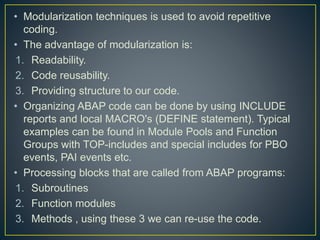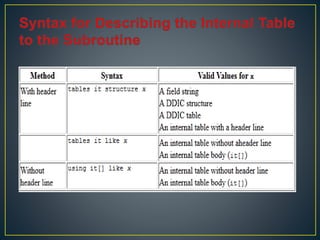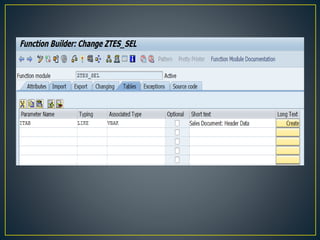Modularization techniques like macros, includes, subroutines, and function modules are used in ABAP to avoid repetitive coding and provide structure, readability, and code reusability. These techniques allow code to be organized, reused, and maintained more easily. Parameters can be passed to subroutines by reference, value, or value and result, and actual parameters in the main program are linked to formal parameters in the subroutine. Typed and generic formal parameters specify how the data types are handled.



![• If you want to reuse the same set of statements more
than once in a program, you can include them in a
macro.
• Syntax :
DEFINE <macro>.
<statements>
END-OF-DEFINITION.
• To use a macro, use the following form:
<macro> [<p1> <p2> ... <p9>].](https://image.slidesharecdn.com/modularization-160202092213/85/SAP-Modularization-techniques-4-320.jpg)
































![• How to Pass an Internal Table Without a Header Line to a Subroutine:
TABLES : MAKT.
DATA : ITAB LIKE MAKT OCCURS 5. " INTERNAL TABLES WITHOUT WORK AREA.
SELECT * FROM MAKT UP TO 5 ROWS INTO TABLE ITAB ORDER BY MATNR.
PERFORM : S1 USING ITAB,
S2 USING ITAB,
S3 USING ITAB,
PRINT TABLES ITAB.
END-OF-SELECTION.
WRITE : / 'END OF SELECTION'.
PERFORM PRINT TABLES ITAB.
*&---------------------------------------------------------------------*
*& Form S1
*&---------------------------------------------------------------------*
* text
*----------------------------------------------------------------------*
* -->P_ITAB text
*----------------------------------------------------------------------*
form S1 using VALUE(p_itab) LIKE ITAB. " PASS BY VALUE
" ALSO YOU CAN USE LIKE ITAB[]
DATA : WA LIKE LINE OF P_ITAB.
READ TABLE P_ITAB INTO WA INDEX 1.
IF SY-SUBRC = 0.
WA-MATNR = '100'.
MODIFY P_ITAB FROM WA INDEX 1.
ENDIF.
endform. " S1](https://image.slidesharecdn.com/modularization-160202092213/85/SAP-Modularization-techniques-37-320.jpg)

























![• REPORT ZCUST MESSAGE-ID ZMEESTAB.
• PARAMETERS : CUSTOM TYPE KNA1-KUNNR.
• DATA : ITAB TYPE TABLE OF VBAK,
• WA TYPE VBAK.
• START-OF-SELECTION.
• CALL FUNCTION 'ZTEST_TABLE'
• EXPORTING
• CUST = CUSTOM
• TABLES
• ITAB = ITAB[]
• EXCEPTIONS
• BLANK = 1
• NO_SALES = 2
• OTHERS = 3
• .
• IF SY-SUBRC = 1.
• MESSAGE I000.
• ELSEIF SY-SUBRC = 2.
• MESSAGE E001.
• ENDIF.
• LOOP AT ITAB INTO WA.
• WRITE : / WA-VBELN , WA-KUNNR ,WA-BSTNK, WA-BSTDK.
• ENDLOOP.](https://image.slidesharecdn.com/modularization-160202092213/85/SAP-Modularization-techniques-63-320.jpg)





![• Field symbols are pointers in C.
• They are used to store the address of variable.
• Used to increase the performance .
• Syntax :
Field symbols <fs> [typing].
• Assigning is the keyword to assign the field symbol to
variable.
• Unassign is the keyword to unassign the field symbol to
variable.](https://image.slidesharecdn.com/modularization-160202092213/85/SAP-Modularization-techniques-69-320.jpg)
